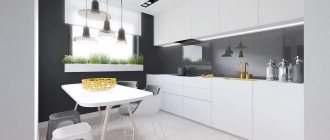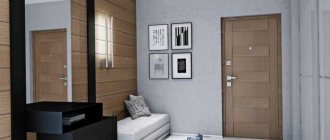Features of minimalism in the interior
Minimalism was formed under the unconditional influence of Japanese culture and philosophy. Europe discovered oriental customs after the Second World War, and could no longer say goodbye to them. Architects, designers and artists have long been tired of pompous classics and happily embraced new trends.
There are still no unified canons for minimalism, because despite all its laconicism it is very diverse. Even now, several trends can be distinguished - Japanese, Scandinavian, high-tech or environmentally friendly. And most often they intertwine with each other, maintaining their general outlines.
Minimalism is always the simplicity of structures, shapes, materials, textures and absolutely everything that you use in the interior. It is dominated by clear geometric lines - it doesn’t matter whether they are angular or rounded. There is no place for unnecessary decorations, decor and endless cute but useless trinkets.
Symmetry in minimalism is an optional matter of mood and personal preference. Functional zoning and combining rooms to increase space are more common. Such living rooms are not cluttered with furniture - they only have the basics and essentials.
Textile
An abundance of textiles in minimalism is bad form. The variety of fabric decor is appropriate in French country, and not in a restrained urban trend. Even if you are designing a living room in a private home, you should give up tablecloths, throws for upholstered furniture and a variety of decorative napkins. These interior elements can look very careless and completely contradict the main principle of the minimalist trend, which is the absence of unnecessary and non-useful items.
When choosing tulle, take a closer look at light, plain fabrics that will not block the penetration of natural light. Curtains can be chosen in contrasting colors. The optimal combination of shades would be to choose curtains to match the dark floor and light tulle, which harmoniously matches the color of the walls.
Color spectrum
Living rooms in the minimalist style are traditionally monochrome or with just one or two bright accents. All surfaces and furniture are designed in the same calm palette, and individuality is given by different little things and textures. For example, colorful sofa cushions, curved chrome lamps or a patchwork rug.
White living room in minimalist style
It’s simply impossible to go wrong with white in a minimalist living room. He himself is the embodiment of the basic concept of style. To avoid the feeling of a hospital room, combine similar shades and dilute them with contrasting black or bright color.
Beige living room in minimalist style
For those who prefer warmer and more comfortable minimalist interiors - beige, cream, milky, sand and all their variations. This is not such a strict and cold option as white. An excellent choice if you prefer not chrome and gloss, but classic wood and natural fabrics.
Gray living room in minimalist style
Gray is a powerful trend of the last three years, which is actively used by modern minimalists around the world. It is good for both more restrained and austere living rooms with a neoclassical bias, and for spectacular futuristic hi-tech. A bright and stylish interior can be decorated using just shades of gray - from silver to graphite.
Black living room in minimalist style
Only owners of really large and bright living rooms can afford to use black as the main color. But black details are a classic in minimalist interiors because they create the very contrast for all basic neutral colors. A black sofa, black facades, shiny black appliances or a black floor - all this is more useful than ever.
Bright accents
Bright colors are practically not used as a basis in minimalist interiors. They already have their own mood and pronounced characteristics - and this contradicts the concept. But bright splashes of color, be it an accent wall or colorful flowerpots, will ideally brighten up a calm living room. Choose more flashy and even acidic shades for modern projects, and complex and deep shades for more traditional ones.
Living room layout and zoning
A living room in the minimalist style in the photo and in reality is a clear and understandable space in which there is no place for unimaginable creative delights, vagueness and unnecessary fantasies. The ideal room for a comfortable rest after a long working day is created against the backdrop of a clear layout and reasonable zoning.
Since a minimalist interior cannot be overloaded with details, everything can be solved with simple techniques:
- furniture arrangement;
- placement of lamps;
- using lightweight partitions;
- shade of finishing materials;
- geometric contours.
But the general concepts are not so clear, because in each style the definition of functional zones looks completely different, especially when they are implemented in different apartments and houses.
Zoning the space of combined rooms, for example, a living room and a kitchen in a minimalist style, can be just as easy and relaxed:
- Traditionally, you can use flooring in different shades or even from different materials - for example, wood in the living area and tiles in the kitchen area.
- The main lamps of the working part of the room are placed along the dining group. At the same time, the lighting system also contains other solutions - illumination of the desktop and apron, TV or recreation area, floor lamps near the sofa.
- Transparent or translucent partitions are another functional and unobtrusive solution for zoning. But they are appropriate only in a fairly spacious volume, and this is clearly not a living room in a Khrushchev-era building, where even in the minimalist style, after combining the premises, the area remains quite small.
Such partitions make it easy to transform the space and protect the recreation area from odors from the kitchen or extraneous noise. Sliding systems can optionally be equipped with blinds or roller blinds, which significantly change the interior. By the way, it is precisely such paintings that can become a real decoration of the living room if you choose discreet but stylish drawings - in the style of Japanese minimalism or abstraction, macro photography or minimalistic landscape (sea and sky, desert and sky).
- You can install frame structures along the contour of a separate zone - along the ceiling or along the “floor-wall-ceiling” perimeter. This is appropriate in a small space where more cumbersome techniques are simply not acceptable.
Minimalism is convenient and accessible for the living room in an ordinary apartment, where it is easy to organize a design, as in a photo from a fashion magazine. A lot of light, a choice of harmonious colors, little furniture - what else is needed for small apartments, in which a small living room cannot be overloaded with details.
However, here, too, to increase the usable area, combining rooms is often used, when for harmony and comfort it is necessary to zone the space. In this case, the easiest solutions are used - exclusively visual zoning with shades of finishing coatings and contour markings of zones.
Materials and textiles
Japanese minimalism was based on natural materials and textures. But since then, the development of style has stepped far forward, so acrylic, artificial stone, metal, plastic, chrome and glass are no less relevant. The main thing is to find harmony between different textures, because the line between eclecticism and tackiness is very thin.
Floor finishing
Laminate is best suited for the living room floor - it is relatively inexpensive, practical and varied. Do not use overly complex designs - a simple imitation of boards with minimal processing is sufficient. Pay attention to self-leveling floors, tiles or porcelain tiles if you are not afraid of the cold or still plan to install convectors.
Wall decoration
Minimalism doesn't require complicated decisions, so just paint the living room walls with one washable paint. Don't be afraid of white and light colors - in fact, they are easy to wash, and if something happens, they can simply be painted over. You can combine several similar shades with a difference of a couple of tones for accents.
Ceiling design
Instead of painted ceilings or multi-level plasterboard structures, use stretch fabrics. Both glossy and matte - they are always smooth, neat and reliably mask any defects in the base. Lamps are built into them almost unnoticeably - without unnecessary bulky fasteners or sockets.
Curtains
Classic curtains do not fit into the style of minimalism at all. And it doesn’t matter whether it’s heavy, luxurious velvet or thin, flowing organza. The best choice is Roman blinds or any other roller blinds that fall exactly along the window and are retracted up when not needed. For sun protection, take two-layer fabrics with a blackout lining.
Materials
Decorating a living room in a minimalistic manner may seem economical only at first glance. When implementing this style, the main emphasis is placed not only on the appearance of the decoration, but also on the quality of the materials that create its picture. And the real price per sq. m of similar building materials usually differs significantly from the market average.
Natural wood is the main source of inspiration for a minimalist designer. Not only floors and furniture can be made of wood, but also decorative panels on the wall, behind which it is convenient to hide wires.
The abundance of stone, glass, glossy and polished surfaces create that same aura of luxurious simplicity inherent in the minimalist trend. You can complement this atmosphere by introducing brickwork, simple metal structures, smooth cement surfaces, porcelain tiles and discreet carpeting into the interior.
Gender: discreet nobility
Practical materials in deep dark shades are most often used to finish the floors in the living room. The optimal solution would be a plain floor covering made of wood or other analogues that imitate it. Porcelain tiles decorated with a laconic carpet in the classic style look especially elegant.
Floors can also be made in light colors that are in harmony with the other decoration of the room. But an important rule should be observed: the color of the floors must be darker and more saturated than the color palette of the furniture sets.
Also, when creating an interior in the spirit of minimalism, it is permissible to use simple and unpretentious linoleum, dark parquet boards or laminate and carpet, which are less practical and easy to clean, but have high aesthetic qualities and a tactilely pleasant surface.
Walls: monochrome
Light walls, devoid of non-functional decor, serve as the perfect backdrop for a minimalist living room composition. When decorating them, you can use a wide variety of materials that can emphasize the atmosphere of rigor and restraint:
- wallpaper suitable for subsequent painting;
- brickwork;
- decorative plaster;
- inserts in the form of panels made of wood or bamboo;
- smooth concrete.
By installing panels from other materials, you can effectively divide the room into functional zones. This technique is especially relevant for small living rooms in “Khrushchev” buildings, in which often after redevelopment the hall turns out to be combined with a kitchen. You can also separate the two areas with a bar counter, in which it is customary to install glass storage units and additional lighting.
Huge windows are the hallmark of the minimalist trend in the interior. If possible, increase window openings if the original dimensions do not meet style standards. When choosing metal-plastic structures, you should not focus on boring classic white windows. Profile manufacturers offer a wide range of interesting colors that imitate wood and natural stone.
Ceiling decoration
An ideal option for decorating ceilings in a living room design in the spirit of minimalism is the installation of suspended and tensioned structures. Typically, the designer’s choice falls on light, monochromatic canvases, but an interior solution in deep dark colors is also acceptable.
The ceiling can be decorated with drawings, but their selection should be taken with special responsibility:
- images should not cover the entire ceiling surface, but should be located only above specifically designated functional areas in the living room;
- Bright ornaments are unacceptable; minimalism is characterized by strict monochrome prints.
French and suspended ceilings can be multi-level. Cascades allow you to equip the surface with additional spotlights, increasing the lighting intensity of the room. But ceiling structures should not be complex and ornate: focus on strict lines and simple geometric shapes.
Furniture selection
First of all, think about it and make a list of the furniture that you really need in the living room. Start with things that you use and don’t consider important out of habit. There is no point in buying a set, a shelving unit or a huge wardrobe if you can do without it.
Wall
Modern walls differ from grandma’s old sets in both layout and content. In essence, these are laconic block structures that can be arranged at your discretion. For example, combine a TV stand with open shelves, closed modules and several narrow pencil cases.
Sofa
The sofa model in a minimalist living room can be any - straight, corner, folding, modular. In this matter, focus on how it will be used in your daily life. The main thing is shapes and textures: no elaborate voluminous sides, carved legs, massive backs or embroidered tapestries instead of upholstery.
Closet
If you need a lot of storage space, replace chests of drawers, cabinets and pencil cases with one large and spacious wardrobe. In a rectangular room, you can even stretch it across the entire narrow wall from floor to ceiling - and at the same time adjust the shape of the room. Choose simple plain or mirrored facades without vinyl stickers or textured sandblasted patterns.
Coffee table
Small glass coffee tables look perfect in modern minimalism. They are almost unnoticeable and do not clutter up the space at all. In more classic interiors, use simple wooden models - but without bent legs, carvings, paintings or complex decor.
Furniture
When selecting sets for a living room in a minimalist style, it is important to find not only aesthetic, but also ergonomic items. The furniture should contain convenient storage niches that will hide personal items from prying eyes.
Preference should be given to low sets with a wooden frame. Ornate carving is considered unnecessary and too pretentious. Correct geometric shapes and a minimum of details are the main directions that you should focus on when searching for furniture sets.
One of the principles of minimalism is maintaining symmetry. An ordinary corner sofa can disrupt the proportional arrangement of interior items, so such furniture should be used with caution.
In the living room of a private house, it is appropriate to install a fireplace, which not only looks aesthetically pleasing, but is also an important part of the heating system. You can decorate the façade of a decorative stove using stone, which will highlight the stylistic features of the room.
Mirrors and glass surfaces can bring a distinctive airiness to a room and create the effect of unlimited space. Minimalism is characterized by the use of glass shelves on natural wood fixtures and elegant tables with glass tops.
TV zone design
If you have a wall, move the TV right there - it will save space and look good. If not, then the TV area can be made into a decorative accent wall - with a textured coating, photographs, posters or other decor. A popular technique is to move the TV into a plasterboard niche, which can be painted inside in a different color and decorated with LED strip.
Lighting and backlighting
Any minimalism should have a lot of light - both natural and artificial. For functionality, use zone lighting, multi-level systems, separate switches and intensity control. This is perhaps the only aspect in which minimalism gravitates towards complex solutions.
Chandelier and lamps
There are no classic chandeliers with pendants in minimalist living rooms. Sometimes series of pendant lamps or entire structures on slats are used - mainly for zoning. For example, three small metal lampshades of different heights above the bar counter.
The classic solution is spotlights around the perimeter or along the walls. If you pull them out in parallel rows, this will visually push the opposite walls apart. And a zoned installation allows you to do away with sconces, floor lamps and even table lamps.
Decorative lighting
The best decorations for a minimalist interior are always functional - like decorative lighting. LED strip can be used to decorate “floating” ceilings, plasterboard structures, a niche with a TV, shelving, open shelves, a sofa, a podium – whatever you want. And if you take LEDs with different modes and colors, this will also help create a festive mood with just one button.
Lighting: making the living room cozy
A modern, light and spacious interior is not complete without a large number of lamps. Minimalism involves complete and varied lighting: chandeliers, pendant and ceiling lamps, spotlights and floor models. The shape of these is usually simple and clear - these are geometric lampshades, often with streamlined lines - in the form of a ball or oval, a softened cone.
Spot lamps are an essential component of a multi-level room lighting system in a minimalist style. They are used in zoning and lighting, as additional light sources.
Small living room in minimalist style
For a small living room, minimalism is a real salvation, because it allows you to save space. Here, use all the techniques and bring them to the maximum. White color, as much light as possible, contrasting verticals and horizontals, a minimum of furniture and lack of trash - even a small room will seem light and spacious.
Lighting
Light is an important component of decoration in any style, but minimalism is characterized by an abundance of luminous flux, which can be obtained by installing powerful lamps. Installing a large chandelier in the center of the room will not solve the problem of sufficient lighting. Therefore, carefully consider the placement plan for recessed ceiling lights.
Floor lamps and lamps, the laconic forms of which emphasize the restrained spirit of minimalism, can diversify the interior. The ability to independently regulate the intensity of the glow will be a godsend for those who plan not only to receive guests in the hall, but also to while away time with loved ones in a calmer and more romantic environment.
Side and cornice lamps are ideal for illuminating the perimeter of a room. With them, even a small living room will remain bright and visually appear more spacious at any time of the day.
Kitchen-living room in minimalist style
An island layout will help you delimit zones. To do this, place the set in one corner, the TV in the other, and divide the space perpendicularly with a sofa or bar counter. Use different materials, but in the same color scheme: white paint with a white kitchen splashback, laminate with wood-effect tiles.
Decorative elements in minimalism
A minimum of decor and accessories is the key to maintaining the authenticity of minimalism as a movement. Impeccable orderliness and the absence of unnecessary details make the interior simple and effective at the same time. Any element of decoration should not only be beautiful, but also rationally useful for home owners.
Do not forget about maintaining symmetry. Therefore, paired objects are often used as functional decor, for example, stylish floor vases or interesting sculptures. It is appropriate to decorate the walls with laconic frames for black and white family photos, the placement of which also respects the proportions.
A plain rug in neutral colors will serve as a great decor for the floor. The coating can be selected either in a related color scheme or in a contrasting shade, combined with the main tone of the walls.
Minimalism in the interior is perfect for both large rooms and small rooms that need rational use of limited space. Simplicity, restraint and emphasis on ergonomics are finding more and more fans among connoisseurs of simple and functional interior solutions.
Living room interior in minimalist style - photo
Despite the deliberate simplicity and laconism of minimalism, each living room has its own character and mood. This is easy to track if you compare different options. To do this, we offer you a large selection of photographs!











